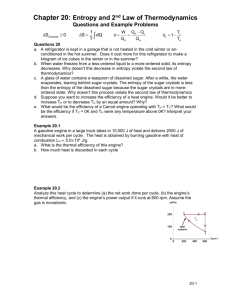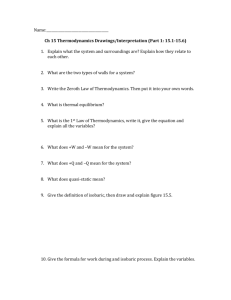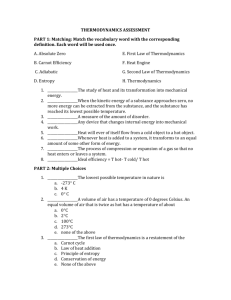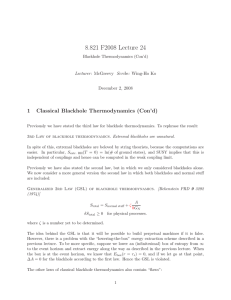ch 21-24 Study guide - CP 2013
advertisement
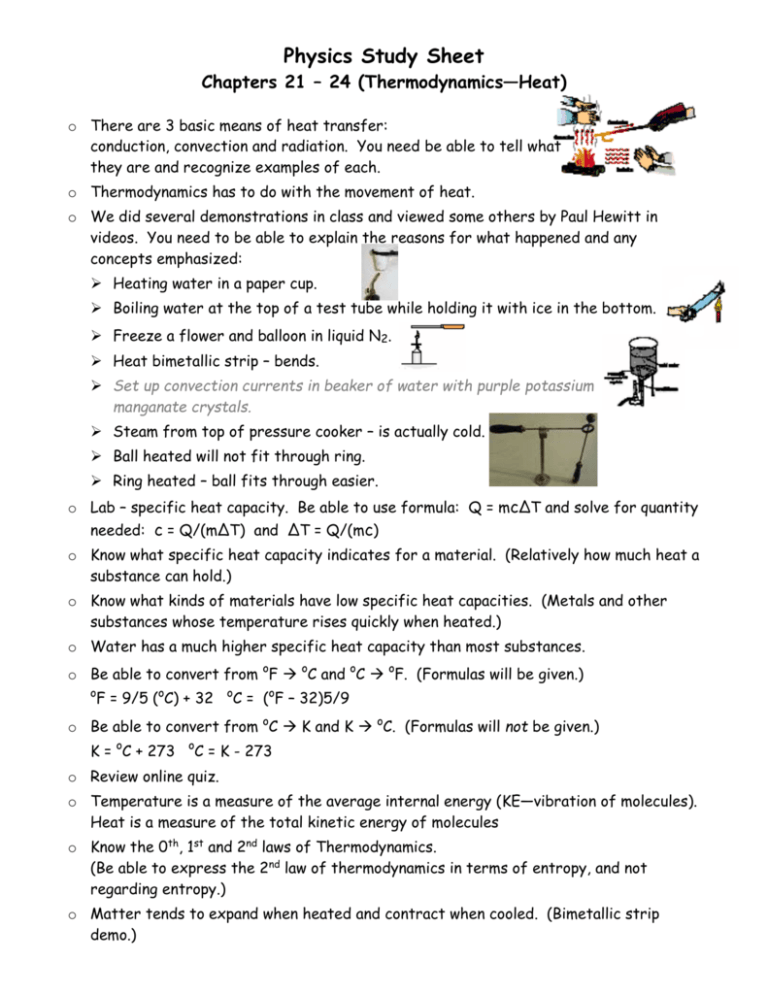
Physics Study Sheet Chapters 21 – 24 (Thermodynamics—Heat) o There are 3 basic means of heat transfer: conduction, convection and radiation. You need be able to tell what they are and recognize examples of each. o Thermodynamics has to do with the movement of heat. o We did several demonstrations in class and viewed some others by Paul Hewitt in videos. You need to be able to explain the reasons for what happened and any concepts emphasized: Heating water in a paper cup. Boiling water at the top of a test tube while holding it with ice in the bottom. Freeze a flower and balloon in liquid N2. Heat bimetallic strip – bends. Set up convection currents in beaker of water with purple potassium manganate crystals. Steam from top of pressure cooker – is actually cold. Ball heated will not fit through ring. Ring heated – ball fits through easier. o Lab – specific heat capacity. Be able to use formula: Q = mcΔT and solve for quantity needed: c = Q/(mΔT) and ΔT = Q/(mc) o Know what specific heat capacity indicates for a material. (Relatively how much heat a substance can hold.) o Know what kinds of materials have low specific heat capacities. (Metals and other substances whose temperature rises quickly when heated.) o Water has a much higher specific heat capacity than most substances. o Be able to convert from oF oC and oC oF. (Formulas will be given.) o F = 9/5 (oC) + 32 o C = (oF – 32)5/9 o Be able to convert from oC K and K oC. (Formulas will not be given.) K = oC + 273 o C = K - 273 o Review online quiz. o Temperature is a measure of the average internal energy (KE—vibration of molecules). Heat is a measure of the total kinetic energy of molecules o Know the 0th, 1st and 2nd laws of Thermodynamics. (Be able to express the 2nd law of thermodynamics in terms of entropy, and not regarding entropy.) o Matter tends to expand when heated and contract when cooled. (Bimetallic strip demo.) o Ice is less dense than water – which is not usually true for nonmetallic substances. o Absolute zero. What that temperature is in degrees Celsius and degrees Fahrenheit. o Know the 10 temperatures for freezing and boiling points of water and absolute zero in degrees Celsius and degrees Fahrenheit. Also know the temperature which is the same in oC and oF (-40o). o A kilocalorie (kcal) is 1000 calories and is often referred to as a Calorie. o Why does a tile floor feel cold, while the wood floor does not, yet they are at the same temperature? (Conductivity of tile is very good.) o Why is the land warmer during the day and a large lake or the ocean warmer at night? (Specific heat of water is much larger than that of land.) o What kinds of objects absorb heat radiation and which kind reflect it? o A good absorber of radiation reflects little radiation and vice-versa. o A good absorber of radiation is also a good emitter of radiation and vice-versa. o A good conductor of electricity is also usually a good conductor of heat. o What is the difference between a conductor and an insulator? o Be able to describe each step in the operation of a refrigerator and an internal combustion engine in terms of the 1st law of thermodynamics, including Q and W. (See handout for notes.) o Understand how a refrigerator works and be able to label a diagram. o Understand how an internal combustion engine (automobile engine) works and be able to label a diagram. o Be able to label a change of state diagram. o Know what latent heats of fusion and vaporization are and be able to label a diagram. o Be able to tell what state(s) (solid, liquid or gas) water would be in at various temperatures, and by regions of a change of state diagram (see above). o Newton’s law of cooling: the rate of cooling—whether by conduction, convection or radiation—is proportional to the temperature difference, ΔT, between the object and its surroundings. o Metals are good conductors and poor insulators. o Poor conductors, such as wood, air and most liquids are good insulators. o Know how Archimedes principle relates to convection currents. o How does a bird warm itself? o How does the temperature of a gas change when compressed? o When gases expand, they do work. When they contract, work is done on them. o Know why heater vents are typically in the floor and AC vents are usually in the ceiling. o As air expands, it cools. o The temperature of air drops by about 10 oC for each kilometer of elevation. o Adiabatic processes are ones in which heat is neither gained nor lost. o Isothermal processes are ones in which the temperature does not change. o What is entropy? (Energy of disorder) o Know how to describe the 2nd law of thermodynamics in terms of entropy. How does this relate to creation-evolution? o A calorimeter, such as you used in our lab, approximates an adiabatic process. o Be able to identify diagrams for a refrigerator (heat pump) and a heat engine (I.C.E) including QH, QC, Work, TH and TC. Q = mwatercwater∆Twater Q = mcT c= Q m T Q heat cmetal = m mass Q mmetalΔTmetal Q = mLf Q = mLv ∆T change in temperature Temperature conversion: 5 9 C = (F – 32o) F = C + 32o 9 5 1st Law of Thermodynamics Q = ∆U + W or ∆U = Q – W if U = 0 W = QH - QC Q heat absorbed by system ∆U change in internal energy or kinetic energy of molecules W work done by system (gas) where

